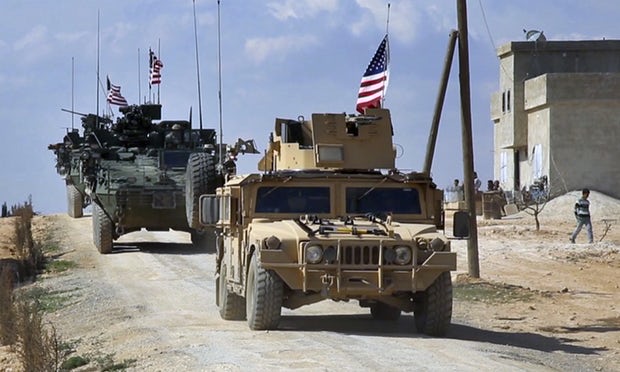The Guardian
Not for the first time there are dire warnings of a direct US-Russia confrontation in Syria that could escalate, in the worst case, into a third world war. What is going on has echoes of the proxy conflicts fought by the superpowers during the latter stages of the cold war, but with added elements of risk because the accepted rules and formal channels of communication to a large extent no longer exist.
The latest alarm sounded after US forces shot down a Syrian government warplane and Russia said it would in future treat any US plane flying west of the Euphrates as a potential target. Russia also announced that it was cutting the Russia-US hotline designed to prevent accidental clashes in the Syrian airspace. The US said it had acted in defence of opposition forces fighting Islamic State. Russia asked on what authority it was striking against the government of a foreign state.
A day later, the US blamed Russia for a near-miss between their warplanes over the Baltic, and disclosed that there had been dozens of such near-misses in the region. The impression was created of inexorably rising tension and growing risk-taking along the whole of the east-west borderlands, with a mistake precipitating a direct clash seemingly only a matter of time.
The most perilous theatre, though, remains Syria, in part because of its complexity. Though in part, too, because the war may be nearing its endgame. President Bashar al-Assad seems now to believe that, with the Russian and Iranian support he commands, he will be able to reassert his rule over the whole of Syria. Talk of partition, new borders, autonomous regions and the rest has largely been silenced. Aleppo is in government hands; the battle for Raqqa is in progress, and the territory controlled by Isis – both in Syria and Iraq – has shrunk.
This may explain why it is now harder for the US and Russia to claim that their chief purpose in Syria is to combat Isis, still less that they might make common cause. It is clear that the conflict in Syria, as it now stands, is first of all about the future of the country and second about competition for regional ascendancy – a competition in which Turkey and Iran are both players. Could this be why the US seems to have become more assertive?
Russia’s objectives in Syria have been clear from the start of its overt military intervention in September 2015 (even if the US and some of its allies refused to see them). It is true that as a longtime ally of Syria since cold-war times, Russia feels a certain loyalty to Assad. It is true, too, that it sees Syria as a place where it can regain some of the influence the Soviet Union had in the Middle East. But these considerations have always been secondary to its determination to keep Syria together as a unified state. To Moscow, Iraq and Libya stand as models for what Syria must be helped to avoid. Russia’s loyalty was only extended to Assad as he was the one person able to keep Syria together. Had a single opposition force emerged, Russia might well have left him to swing in the wind. But the opposition has never been united enough to present a credible alternative – even with the help it received from the US and others. Moscow has put pressure on Assad to accept elections and some form of power-sharing, but the military conflict must be over first. Its priority remains the unity and governability of Syria.
The US position, in contrast, looks inconsistent, to put it politely. While Barack Obama was president, the US supported a variety of opposition groups, and insisted – though the then-secretary of state, John Kerry, showed some flexibility – that Assad’s departure was a precondition for any settlement. Combating Isis was both part of the same purpose and distinct. It was thought that the election of Donald Trump could presage a sharp change in Syria policy. On the one hand, his hope of improving relations with Russia suggested the possibility of a settlement jointly underwritten. On the other, Trump had pledged to keep the US out of foreign wars and seemed not to regard Syria as a vital US interest. It seemed possible that the US would stand by as Assad capitalised on his victory at Aleppo and hastened to reassert control over the rest of the country. The US policy change, though, never really happened. The rapprochement with Moscow never even began, because of the hue and cry against Russia in Washington. Trump decided – or was persuaded – to enforce a “red line” that had been Obama’s, not his, and launched an air strike on a Syrian government airfield in response to evidence of a chemical attack on civilians. US support for rebel groups continued, to the point where the Syrian warplane was shot down by US forces last weekend. At the very least there are mixed messages here.
One explanation might be the general disorder in the US administration, where many jobs remain unfilled and hostility towards Trump remains high. Another could be the sense – in both Washington and Moscow – that the end is indeed nigh and that, while Russia will retain or enhance its influence, the US needs to stake a claim. Yet another would be Trump’s deep – and dangerous – animus against Iran.
None of this is consoling. All that could be said in mitigation is that Moscow’s consistency is easily read. However, if this is the start of the endgame, it could be the most perilous time, as US-Russia competition for a say in the peace increases the risk of an accidental war.

